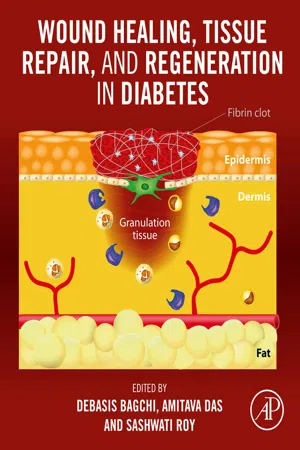
Wound Healing, Tissue Repair, and Regeneration in Diabetes
- 638 pages
- English
- ePUB (mobile friendly)
- Available on iOS & Android
Wound Healing, Tissue Repair, and Regeneration in Diabetes
About This Book
Wound Healing, Tissue Repair and Regeneration in Diabetes explores a wide range of topics related to wound healing, tissue repair and regeneration, putting a special focus on diabetes and obesity. The book addresses the molecular and cellular pathways involved in the process of wound repair and regeneration. Other sections explore a wide spectrum of nutritional supplements and novel therapeutic approaches, provide a comprehensive overview, present various types of clinical aspects related to diabetic wounds, including infection, neuropathy, and vasculopathy, provide an exhaustive review of various foods, minerals, supplements and phytochemicals that have been proven beneficial, and assess future directions.
This book is sure to be a welcome resource for nutritionists, practitioners, surgeons, nurses, wound researchers and other health professionals.
- Explains diabetic wounds and their complications
- Assesses the role of nutraceuticals, herbal supplements and other modalities for use in treating diabetic wounds
- Provides protocols for diabetic wound management
Frequently asked questions
Information
The diabetic foot
Abstract
Keywords
1 Introduction
2 Clinical classification
2.1 Definition
2.2 Risk factors
2.3 Etiology
2.4 Epidemiology
3 The complicated diabetic foot
3.1 Vascular
3.2 Neural
Table of contents
- Cover image
- Title page
- Table of Contents
- Copyright
- Dedication
- Contributors
- About the authors
- Preface
- Part 1: Background and overview
- Part 2: Molecular mechanisms in diabetic wounds
- Part 3: Emerging therapeutics in diabetic wound care
- Part 4: Nanotechnology and nanocarriers in wound healing
- Part 5: Biomarkers in wound healing
- Part 6: Novel concepts in diabetic wound healing
- Index